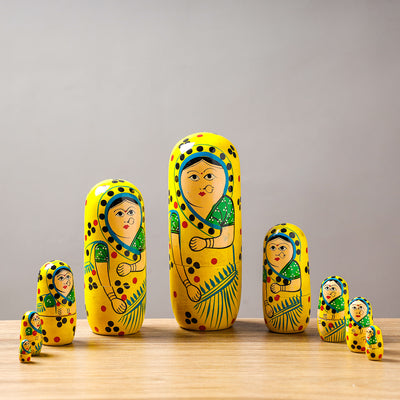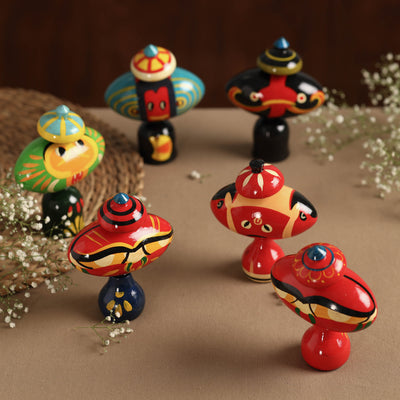An introduction to Banaras toy craft:
One of the most famous and traditional crafts that are practiced in Varanasi, or Banaras, in Uttar Pradesh, India, is the art of traditional toy making and toy craft. Having been practiced for several generations now, it has become one of the trademarks of the area, and is still continued and respected in high regard by the locals. In the year 2014, it also received the Geographical Indication tag, representing that the product possesses both fame and quality based on this region of production, and vice versa.
History of Banaras Crafts:
One of the oldest known cities of India, Varanasi was known to be the original hub of the Aryan settlement in the 2nd millennium BCE. The inhabitants were known to be participative in various activities like silk production, ivory works, and perfume making, and specialized in the making of wooden toys as well. This is where the journey of this craft began, and the people of the city continued the legacy of the art. Varanasi also came to be known as the Hindu center for learning, and was occupied by many Brahmin pandits and educators that started teaching in schools. These schools also encouraged activities like arts and crafts for the students' development, where they started indulging in the making of wooden toys, among other crafts. The craftsmen of Varanasi encouraged this even more after the ban of ivory, and switched their focus completely to the use of wood for production.

Process of Banaras Crafting:
Corea wood was the type of wood that was initially used as the raw material for producing these toys. This kind of wood was preferred due to its characteristics, which involved the wood is soft, and also malleable, which made it easier for the craftsman to shape it and work with it, which helped in giving the toys and fine finishing. Cutting down of teakwood and Corea was put into a ban by the Government in the 1980’s in an attempt to safeguard it and prevent exhaustion of the resource, and since then wooden toy craftsmen started using Sheesham, Liptus and even Eucalyptus wood for the toys. These are harder to work with as they are less malleable, which makes them tougher to carve. 
The craftsmen cut, peel and shape the wood, with special knives and other tools, after which they are shaped. Pieces of wood the size of the toy are cut from the larger logs, after which they are heated slowly in order to remove any kind of moisture present in the wood. It is then smoothed using sandpaper, or ‘sanded’ to make the surface workable and smooth. The wood is either carved or worked on using ‘lathe’, and in both cases, the design of the toy is etched onto the wood before it is carved, to map out the final result. Chisels or hammers are used to carve out the drawn design and are used selectively based on the shapes of the design. They are usually found in spherical, cylindrical forms and are made into items like pen stands, idols of deities, animals and bird shapes, as well as boxes. Some of the other materials used are sealing was, and fresh paints, which are used to enhance the look of the toys, and give it some vibrancy and shine. These items are made to be small, and the highest height for these would be around 4 inches. The craftsmen and potters of the Prajapati community have taken the responsibility of painting these toys for many years. One of the main festivities for showcasing these products is on Janmashtami which is the birth of Krishna, and the best time for the production and sale of these wooden crafts is between the months of July and November.
Banaras Toys
from Banaras
Fact:
The paint brushes that are used to paint toys are usually made from squirrels, tails, which help the craftsmen and painters to be able to fill in the designs that require fine linings and precision. The toys are then coated with a layer of lacquer, which is either clear or coloured.
Future and survival of Banaras wooden toy:
The wood that is used in the craft of making these toys, is known to be in high demand. These toys also see a great demand in countries abroad, as the paint and materials used for these are germ-free and safe for children’s use, and harmless even if the child ends up putting the toy in its mouth, making it a very suitable toy for younger kids to play with. 
Since the Government banned the cutting of trees, in order to prevent scarcity of wood, they started giving more opportunities to the toy craftsmen to present their work, one of the main sources being the display and presentation of the crafts at the exhibition held on 26th January in India, in honor of Republic Day.

Banaras Toy Crafts available on iTokri:
The iTokri handicrafts store houses a variety of unique and vibrant toys from the Banaras crafts and toys line, including some artifacts that could also double up as home decor, or statement pieces. Some of these are a set of 12 tiny animals, or a big, grand Rajasthani elephant toy, or even a hand painted wooden glass holder that could be a perfect piece to add to any home. iTorki believes in uplifting all the craftsmen and artisans, and they try to do the same with these products to help the hardworking communities.
Blogs you might also like:
Chopad - The oldest indigenous game of India
Ecokaari - upcycling story
All you need to know about magnificient sarees of Odisha
REFERENCES
- https://www.itokri.com/collections/banaras-toy-craft
- https://en.wikipedia.org/wiki/Wooden_Toys_of_Varanasi
- https://www.dsource.in/resource/wooden-toys-varanasi-uttar-pradesh/introduction


















Leave a comment (all fields required)